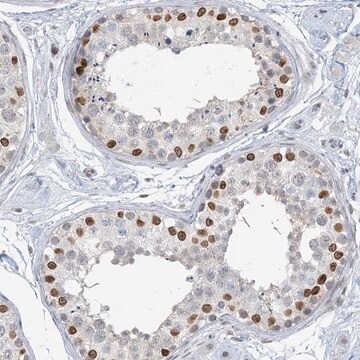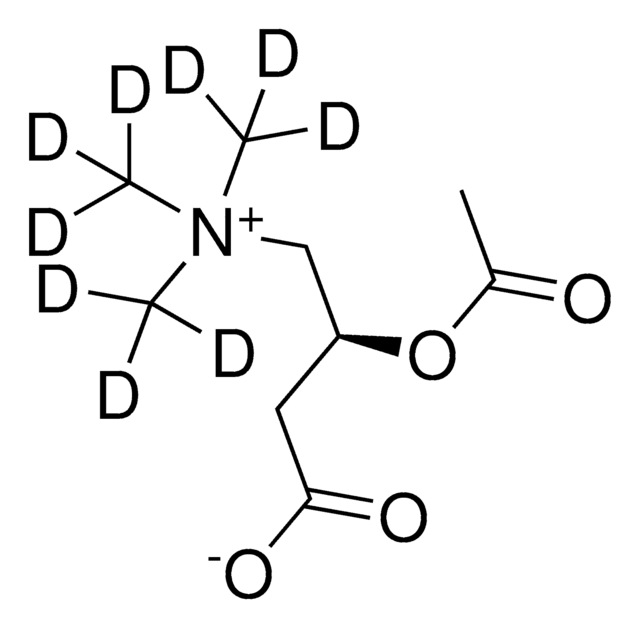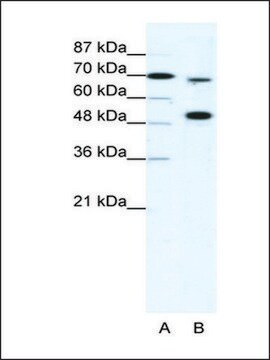추천 제품
생물학적 소스
rabbit
Quality Level
항체 형태
affinity isolated antibody
항체 생산 유형
primary antibodies
클론
polyclonal
정제법
affinity chromatography
종 반응성
human, mouse
기술
ChIP: suitable (ChIP-seq)
western blot: suitable
NCBI 수납 번호
UniProt 수납 번호
배송 상태
ambient
타겟 번역 후 변형
unmodified
유전자 정보
human ... KMT2D(8085)
일반 설명
Histone-lysine N-methyltransferase 2D (EC 2.1.1.43; UniProt O14686; also known as MLL4, ALL1-related protein, Lysine N-methyltransferase 2D) is encoded by the KMT2D (also known as MLL4, ALR, KABUK1, MLL2) gene (Gene ID: 8085) in human. MLL4 methylates Lys-4 of histone H3 to form H3K4 mono- and di-methylation (H3K4me1/2), which represents a specific tag for transcriptional enhancers. MLL4 is also a component of the MLL3/4 protein complex that plays an important role during cell differentiation and animal development. MLL4 is localized to the nucleus and is expressed in most embryonic and adult tissues. Defects in MLL4 (often known as KMT2D in the literature) have been linked to Kabuki syndrome and congenital heart diseases. Inactivating mutations in MLL4/MLL2/KMT2D gene have been linked to many types of cancers, including medulloblastoma, non-Hodgkin lymphoma, diffuse large B-cell lymphoma, prostate cancer, breast cancer, hepatocellular carcinoma, ovarian cancer, lung, bladder, head & neck cancers, and pancreatic cancer. (Ref.: Lee, J.E., et al. (2013). Elife. 2:e01503; Lawrence, M.S., et al., (2014). Nature. 505(7484):495-501).
특이성
This polyclonal antibody targets the region between the first and third coiled coil of MLL4 sequence.
면역원
Epitope: unknown
His-tagged recombinant human MLL4 internal fragment from the region between the first and third coiled coil.
애플리케이션
Anti-MLL4, Cat. No. ABE1867, is a highly specific rabbit polyclonal antibody that targets MLL4 (also known as KMT2D) and has been tested in Chromatin Immunoprecipitation (ChIP), ChIP-seq, Immunoprecipitation, and Western Blotting.
Research Category
Epigenetics & Nuclear Function
Epigenetics & Nuclear Function
Western Blotting Analysis: A 1:500 dilution of the unpurified antiserum detected the expression of Myc-tagged human MLL4 a.a. 2916-3785, but not a.a. 3662-4625, fragment in 100 µg whole cell lysate from respective transfectants (Courtesy of Dr Lee from NIH).
Chromatin Immunoprecipitation (ChIP) Analysis: A representative lot detected MLL4 (MLL2) occupancy on the PPAR 1, but not the PPAR 2, proximal promoter in MEFs, while MLL4 enrichment was found on PPARγ1, PPARγ2, and C/EBP promoters in differentiating murine brown preadipocytes (Cho, Y.W., et al. (2009). Cell Metab. 10(1):27-39).
ChIP-Sequencing (ChIP-seq) Analysis: A representative lot detected MLL4 MLL4 genomic enrichment sites in a cell type- and differentiation stage-specific manner (Lee, J.E., et al. (2013). Elife. 2:e01503).
Immunoprecipitation Analysis: A representative lot immunoprecipitated MLL3/MLL4 complex components (UTX, PTIP, RbBP5 and PA1) and C/EBPβ, but not Menin, from mouse brown preadipocyte nuclear extracts prepared at day 2 of adipogenesis (Lee, J.E., et al. (2013). Elife. 2:e01503).
Chromatin Immunoprecipitation (ChIP) Analysis: A representative lot detected MLL4 (MLL2) occupancy on the PPAR 1, but not the PPAR 2, proximal promoter in MEFs, while MLL4 enrichment was found on PPARγ1, PPARγ2, and C/EBP promoters in differentiating murine brown preadipocytes (Cho, Y.W., et al. (2009). Cell Metab. 10(1):27-39).
ChIP-Sequencing (ChIP-seq) Analysis: A representative lot detected MLL4 MLL4 genomic enrichment sites in a cell type- and differentiation stage-specific manner (Lee, J.E., et al. (2013). Elife. 2:e01503).
Immunoprecipitation Analysis: A representative lot immunoprecipitated MLL3/MLL4 complex components (UTX, PTIP, RbBP5 and PA1) and C/EBPβ, but not Menin, from mouse brown preadipocyte nuclear extracts prepared at day 2 of adipogenesis (Lee, J.E., et al. (2013). Elife. 2:e01503).
품질
Evaluated by Western Blotting of recombinant MLL4 fragment.
Western Blotting Analysis: A 1:5,000 dilution of this antibody detected 50 ng of recombinant human MLL4 fragment.
Western Blotting Analysis: A 1:5,000 dilution of this antibody detected 50 ng of recombinant human MLL4 fragment.
표적 설명
593.4/593.7 kDa (human isoform 1/2) and 600.2 kDa (mouse) calculated.
물리적 형태
Affinity purified.
Purified rabbit polyclonal antibody in buffer containing 0.1 M Tris-Glycine (pH 7.4), 150 mM NaCl with 0.05% sodium azide.
저장 및 안정성
Stable for 1 year at 2-8°C from date of receipt.
기타 정보
Concentration: Please refer to lot specific datasheet.
면책조항
Unless otherwise stated in our catalog or other company documentation accompanying the product(s), our products are intended for research use only and are not to be used for any other purpose, which includes but is not limited to, unauthorized commercial uses, in vitro diagnostic uses, ex vivo or in vivo therapeutic uses or any type of consumption or application to humans or animals.
적합한 제품을 찾을 수 없으신가요?
당사의 제품 선택기 도구.을(를) 시도해 보세요.
Storage Class Code
12 - Non Combustible Liquids
WGK
WGK 1
시험 성적서(COA)
제품의 로트/배치 번호를 입력하여 시험 성적서(COA)을 검색하십시오. 로트 및 배치 번호는 제품 라벨에 있는 ‘로트’ 또는 ‘배치’라는 용어 뒤에서 찾을 수 있습니다.
Balkees Abderrahman et al.
Molecular cancer therapeutics, 20(1), 11-25 (2020-11-13)
Patients with long-term estrogen-deprived breast cancer, after resistance to tamoxifen or aromatase inhibitors develops, can experience tumor regression when treated with estrogens. Estrogen's antitumor effect is attributed to apoptosis via the estrogen receptor (ER). Estrogen treatment can have unpleasant gynecologic
Jill A Fahrner et al.
JCI insight, 4(20) (2019-09-27)
Kabuki syndrome 1 (KS1) is a Mendelian disorder of the epigenetic machinery caused by mutations in the gene encoding KMT2D, which methylates lysine 4 on histone H3 (H3K4). KS1 is characterized by intellectual disability, postnatal growth retardation, and distinct craniofacial
자사의 과학자팀은 생명 과학, 재료 과학, 화학 합성, 크로마토그래피, 분석 및 기타 많은 영역을 포함한 모든 과학 분야에 경험이 있습니다..
고객지원팀으로 연락바랍니다.








